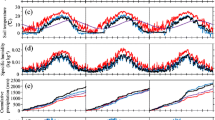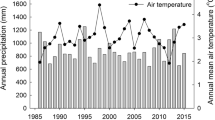Abstract
Capacity of carbon sequestration in forest ecosystem largely depends on the trend of net primary production (NPP) and the length of ecosystem carbon residence time. Retrieving spatial patterns of ecosystem carbon residence time is important and necessary for accurately predicting regional carbon cycles in the future. In this study, a data-model fusion method that combined a process-based regional carbon model (TECO-R) with various ground-based ecosystem observations (NPP, biomass, and soil organic carbon) and auxiliary data sets (NDVI, meteorological data, and maps of vegetation and soil texture) was applied to estimate spatial patterns of ecosystem carbon residence time in Chinese forests at steady state. In the data-model fusion, the genetic algorithm was used to estimate the optimal model parameters related with the ecosystem carbon residence time by minimizing total deviation between modeled and observed values. The results indicated that data-model fusion technology could effectively retrieve model parameters and simulate carbon cycling processes for Chinese forest ecosystems. The estimated carbon residence times were highly heterogenous over China, with most of regions having values between 24 and 70 years. The deciduous needleleaf forest and the evergreen needleleaf forest had the highest averaged carbon residence times (73.8 and 71.3 years, respectively), the mixed forest and the deciduous broadleaf forest had moderate values (38.1 and 37.3 years, respectively), and the evergreen broadleaf forest had the lowest value (31.7 years). The averaged carbon residence time of forest ecosystems in China was 57.8 years.
Similar content being viewed by others
References
Solomon S, Qin D, Manning M, et al. Climate Change 2007: The Physical Science Basis. New York: Cambridge University Press, 2007
Young L M. Carbon sequestration in agriculture: The U. S. policy context. Am J Agr Econ, 2003, 85: 1164–1170
Fang J Y, Guo Z D, Piao S L, et al. Terrestrial vegetation carbon sinks in China, 1981–2000. Sci China Ser D-Earth Sci, 2007, 50: 1341–1350
Andrasko K. Climate Change and Global Forests: Current Knowledge of Potential Effects, Adaption and Mitigation Options. Rome: FAO Forestry Department, 1990
Brown S, Sathaye J, Cannell M, et al. Management of forests for mitigation of greenhouse gas emissions. In: Watson R T, Zinyowera M C, Moss R H, eds. Climate Change 1995: Impacts, Adaptations and Mitigation of Climate Change. Cambridge: Cambridge University Press, 1996. 773–798
Cannell M G R, Milne R, Haigreaves K J, et al. National inventories of terrestrial carbon sources and sinks: The UK experience. Clim Change, 1999, 42: 505–530
Dai M H, Zhai W D, Lu Z M, et al. Regional studies of carbon cycles in China: Progress and perspectives (in Chinese). Adv Earth Sci, 2004, 2: 120–130
Canadell J G, Corinne L Q, Raupach M R, et al. Contributions to accelerating atmospheric CO2 growth from economic activity, carbon intensity, and efficiency of natural sinks. Proc Natl Acad Sci, 2007, doi: 10.1073/pnas.0702737104
Luo Y, White L, Josep G, et al. Sustainability of terrestrial carbon sequestration: A case study in Duke Forest with inversion approach. Glob Biogeochem Cycle, 2003, 17: 1021, doi: 10.1029/2002GB 001923
Luo Y, Wu L, Andrews A, et al. Elevated CO2 differentiates ecosystem carbon processes: Deconvolution analysis of Duke forest FACE data. Ecol Monogr, 2001, 71: 357–376
Barrett D J. Steady state turnover time of carbon in the carbon in the Australian terrestrial biosphere. Glob Biogeochem Cycle, 2002, 16: 1108, doi: 10.1029/2002GB001860
Xu T, White L, Hui D, et al. Probabilistic inversion of a terrestrial ecosystem model: Analysis of uncertainty in parameter estimation and model prediction. Glob Biogeochem Cycle, 2006, 20: GB2007, doi: 10.1029/2005GB002468
Zhou T, Luo Y. Spatial patterns of ecosystem carbon residence time and NPP-driven carbon uptake in the conterminous United States. Glob Biogeochem Cycle, 2008, 22: GB3032, doi: 10.1029/2007GB 002939
Hicke J A, Asner G P, Randerson J T, et al. Trends in North American net primary productivity derived from satellite observations, 1982–1998. Glob Biogeochem Cycle, 2002, 16: 1018, doi: 10.1029/ 2001GB001550
Nemani R R, Keeling C D, Hashimoto H, et al. Climate-driven increases in global terrestrial net primary production from 1982 to 1999. Science, 2003, 300: 1560–1563
Piao S, Fang J, Zhou L M, et al. Changes in vegetation net primary productivity from 1982 to 1999 in China. Glob Biogeochem Cycle, 2005, 19: GB2027, doi: 10.1029/2004GB002274
Vogt K A, Vogt D J, Palmiotto P A, et al. Review of root dynamics in forest ecosystems grouped by climate, climatic forest type and species. Plant Soil, 1996, 187: 159–219
Gaudinski J B, Trumbore S E, Davidson E A, et al. The age of fine-root carbon in three forests of the eastern United States measured by radiocarbon. Oecologia, 2001, 129: 420–429
Raupach M R, Rayner P J, Barrett D J, et al. Model-data synthesis in terrestrial carbon observation: Methods, data requirements and data uncertainty specification. Glob Change Biol, 2005, 11: 378–397
Potter C S, Randerson J T, Field C B, et al. Terrestrial ecosystem production: A process model based on global satellite and surface data. Glob Biogeochem Cycle, 1993, 7: 811–841
Field C B, Randerson J T, Malmstrom C M. Global net primary production: Combining ecology and remote sensing. Remote Sens Environ, 1995, 51: 74–88
Ruimy A, Saugier B. Methodology for estimation of terrestrial net primary production from remotely sensed data. J Geophys Res, 1994, 97: 18515–18521
Randerson J T, Thompson M V, Malmstrom C M, et al. Substrate limitations for heterotrophs: Implications for models that estimate the seasonal cycle of atmospheric CO2. Glob Biogeochem Cycle, 1996, 10: 585–602
Schimel D S, Braswell B H, Holland E A, et al. Climatic, edaphic, and biotic controls over storage and turnover of carbon in soils. Glob Biogeochem Cycle, 1994, 8: 279–293
Parton W J, Schimel D S, Cole C V, et al. Analysis of factors controlling soil organic matter levels in Great Plains grasslands. Soil Sci Soc Am J, 1987, 51: 1173–1179
Luo T X. Patterns of net primary productivity for Chinese major forest types and its mathematical models (in Chinese). Doctoral Dissertation. Beijing: Institute of Geographic Sciences and Natural Resources Research, Chines Academy of Sciences, 1996
Wang S, Zhou C, Li K, et al. Study on spatial distribution character analysis of the soil organic Carbon Reservoir in China. J Geogr Sci, 2001, 11: 3–13
Wang S, Tian H, Liu J, et al. Pattern and change of soil organic carbon storage in China: 1960s–1980s. Tellus Ser B-Chem Phys Meteorol, 2003, 55: 416–427
Yu G R, He H L, Liu X A, et al. Atlas for Spatialized Information of Terrestrial Ecosystem in China-Volume of Climatological Elements (in Chinese). Beijing: China Meteorological Press, 2004
Deng S Q. Map of Soil Texture of China. In: Institute of Soil Science, Chinese Academy of Sciences, ed. The Soil Atlas of China (in Chinese). Beijing: Cartographic Publishing House, 1986. 23–24
Haupt R L, Haupt S E. Practical Genetic Algorithms. 2nd ed. Hoboken: John Wiley & Sons Publication Inc, 2004
White L, Luo Y, Xu T. Carbon sequestration: inversion of FACE data and prediction. Appl Math Comput, 2005, 163: 783–800
Running S W, Thornton P E, Nemani R, et al. Global terrestrial gross and net primary productivity from the earth observing system. In: Sala O, Jackson R, Mooney H, eds. Methods in Ecosystem Science. New York: Springer-Verlag, 2000. 44–57
Zhu W Q, Pan Y Z, He H, et al. Simulation of maximum light use efficiency for some typical vegetation types in China. Chin Sci Bull, 2006, 51: 457–463
Peng S L, Guo Z H, Wang B S. Use of GIS and RS to estimate the light utilization efficiency of the vegetation in Guangdong, China (in Chinese). Acta Ecol Sin, 2000, 20: 903–909
Author information
Authors and Affiliations
Corresponding author
Rights and permissions
About this article
Cite this article
Zhou, T., Shi, P., Jia, G. et al. Spatial patterns of ecosystem carbon residence time in Chinese forests. Sci. China Earth Sci. 53, 1229–1240 (2010). https://doi.org/10.1007/s11430-010-3061-9
Received:
Accepted:
Published:
Issue Date:
DOI: https://doi.org/10.1007/s11430-010-3061-9




